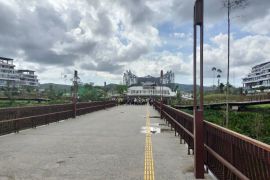"I do not think any of our centers (officials) throughout Indonesia are allowed to go to Jakarta, except with the permission of the PUPR minister. (It is) because we are all ready to face the transition season," the minister stated here on Tuesday.
Hadimuljono also noted that in facing the transition season, all regions of Indonesia are a priority for the PUPR Ministry. The ministry also continues to coordinate with the Meteorology, Climatology, and Geophysics Agency (BMKG).
"All regions in Indonesia are my priority, coordinating with BMKG. BMKG always gives warnings," he remarked.
The BMKG earlier appealed to the public to be aware of the potential for extreme weather during the transition period that is forecast to take place from March to April 2024.
During this period, the public needs to increase awareness and early anticipation of the potential for extreme weather, such as heavy rain in a short duration, which can be accompanied by lightning and strong winds, whirlwinds, and hail.
Related news: BMKG asks Indonesians to watch out for potential rainstorms
Head of BMKG Dwikorita Karnawati stated that based on the analysis of atmospheric dynamics conducted by BMKG, currently, the peak of the rainy season in various regions of Indonesia has passed, especially in the southern part of Indonesia.
According to Karnawati, this indicated that the region would start to enter the seasonal transition period from March to April.
One of the characteristics of the transition of seasons is the pattern of rainfall that usually occurs in the afternoon until late evening, preceded by warm and hot air in the morning until midday.
This condition occurs because the solar radiation received from morning to noon is quite high and triggers a convection process, or lifting of air masses, from the earth's surface into the atmosphere, thereby triggering the formation of clouds.
Karnawati explained that the characteristics of rain during this period tended to be uneven, with moderate to heavy intensity in a short duration of time.
If atmospheric conditions become unstable, the potential for the formation of convective clouds, such as Cumulonimbus (CB) clouds, will increase.
Related news: Govt to introduce weather-resistant tuber to tackle Papua famine
Translator: Aji Cakti, Katriana
Editor: Yuni Arisandy Sinaga
Copyright © ANTARA 2024












